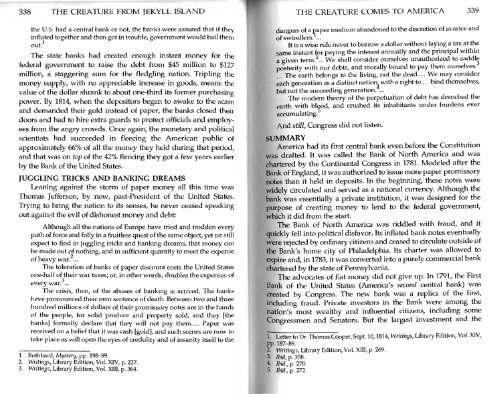Create successful ePaper yourself
Turn your PDF publications into a flip-book with our unique Google optimized e-Paper software.
338 THE CREATURE FROM JEKYLL ISLAND<br />
the U.S. had a central bank or not, the banks were assured that if they<br />
inflated together and then got in trouble, government would bail them<br />
out 1<br />
The state banks had created enough instant money for the<br />
federal government to raise the debt from $45 million to $127<br />
million, a staggering sum for the fledgling nation. Tripling the<br />
money supply, with no appreciable increase in goods, means the<br />
value of the dollar shrank to about one-third its former purchasing<br />
power. By 1814, when the depositors began to awake to the scam<br />
and demanded their gold instead of paper, the banks closed their<br />
doors and had to hire extra guards to protect officials and employees<br />
from the angry crowds. Once again, the monetary and political<br />
scientists had succeeded in fleecing the American public of<br />
approximately 66% of all the money they held during that period,<br />
and that was on top of the 42% fleecing they got a few years earlier<br />
by the Bank of the United States.<br />
JUGGLING TRICKS AND BANKING DREAMS<br />
Leaning against the storm of paper money all<br />
this time was<br />
Thomas Jefferson, by now, past-President of the United States.<br />
Trying to bring the nation to its senses, he never ceased speaking<br />
out against the evil of dishonest money and debt:<br />
Although all the nations of Europe have tried and trodden every<br />
path of force and folly in a fruitless quest of the same object, yet we still<br />
expect to find in juggling tricks and banking dreams, that money can<br />
be made out of nothing, and in sufficient quantity to meet the expense<br />
of heavy war. ...<br />
The toleration of banks of paper discount costs the United States<br />
one-half of their war taxes; or, in other words, doubles the expenses of<br />
every war. ...<br />
The crisis, then, of the abuses of banking is arrived. The banks<br />
have pronounced their own sentence of death. Between two and three<br />
hundred millions of dollars of their promissory notes are in the hands<br />
of the people, for solid produce and property sold, and they [the<br />
banks] formally declare that they will not pay them.... Paper was<br />
received on a belief that it was cash [gold], and such scenes are now to<br />
take place as will open the eyes of credulity and of insanity itself to the<br />
1. Rothbard, Mystery, pp. 198-99.<br />
2. Writings, Library Edition, Vol. XIV, p. 227.<br />
3. Writings, Library Edition, Vol. XIII, p. 364.<br />
THE CREATURE COMES TO AMERICA 339<br />
dangers of a paper medium abandoned to the discretion of avarice and<br />
of swindlers. ...<br />
It is a wise rule never to borrow a dollar without laying a tax at the<br />
same instant for paying the interest annually and the principal within<br />
a given term. 2 ... We shall consider ourselves unauthorized to saddle<br />
posterity with our debts, and morally bound to pay them ourselves.<br />
... The earth belongs to the living, not the dead.... We may consider<br />
each generation as a distinct nation with a right to . . .<br />
bind themselves,<br />
but not the succeeding generation. ...<br />
The modern theory of the perpetuation of debt has drenched the<br />
earth with blood, and crushed its inhabitants under burdens ever<br />
accumulating.<br />
And still, Congress did not listen.<br />
SUMMARY<br />
America had its first central bank even before the Constitution<br />
was drafted. It was called the Bank of North America and was<br />
chartered by the Continental Congress in 1781. Modeled after the<br />
Bank of England, it was authorized to issue more paper promissory<br />
notes than it held in deposits. In the beginning, these notes were<br />
widely circulated and served as a national currency. Although the<br />
bank was essentially a private institution, it was designed for the<br />
purpose of creating money to lend to the federal government,<br />
which it did from the start.<br />
The Bank of North America was riddled with fraud, and it<br />
quickly fell into political disfavor. Its inflated bank notes eventually<br />
were rejected by ordinary citizens and ceased to circulate outside of<br />
the Bank's home city of Philadelphia. Its charter was allowed to<br />
expire and, in 1783, it was converted into a purely commercial bank<br />
chartered by the state of Pennsylvania.<br />
The advocates of fiat money did not give up. In 1791, the First<br />
Bank of the United States (America's second central bank) was<br />
created by Congress. The new bank was a replica of the first,<br />
including fraud. Private investors in the Bank were among the<br />
nation's most wealthy and influential citizens, including some<br />
Congressmen and Senators. But the largest investment and the<br />
I<br />
Letter to Dr. Thomas Cooper, Sept. 10, 1814, Writings, Library Edition, Vol. XIV,<br />
pp. 187-89.<br />
2. Writings, Library Edition, Vol. XIII, p. 269.<br />
3. Ibid, p. 358.<br />
4. Ibid., p. 270.<br />
5. Ibid., p. 272.


